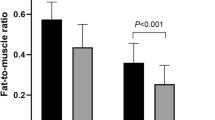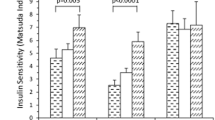Abstract
Purpose
We previously reported that the body muscle-to-fat ratio (BMFR), measured using bioelectrical impedance, significantly correlated with whole-body insulin sensitivity. We examined BMFR gender-specific cut-off values for impaired insulin sensitivity in treatment-naïve type 2 diabetes mellitus (T2DM) patients.
Methods
Subjects included 101 untreated T2DM patients (male, 66; female, 35). We performed a hyperinsulinemic–euglycemic clamp examination to measure the steady-state glucose infusion rate (M value) as an indicator of whole-body insulin resistance. We defined the M value divided by the steady-state serum insulin value as the M/I value. We defined the existence of insulin resistance using an M/I ratio <9.0. The optimal cut-off value for BMFR was calculated by receiver operating characteristics (ROC) analysis.
Results
The cut-off value of the BMFR for insulin resistance was 2.75 (area under the curve [AUC] = 0.83, sensitivity 75%, and specificity 76%, P < 0.001) for males and 1.65 (AUC = 0.87, sensitivity 84%, and specificity 81%, P < 0.001) for females. Simple linear regression analysis showed that BMFR was significantly correlated with the M/I value in both genders (males, B = 0.77, P< 0.01; females, B = 0.83, P< 0.01).
Conclusions
BMFR cut-off values for impaired insulin sensitivity in treatment-naïve T2DM patients were 2.75 for males and 1.65 for females.


Similar content being viewed by others
References
E.S. Ford, Prevalence of the metabolic syndrome defined by the International Diabetes Federation among adults in the US. Diabetes Care 28, 2745–2749 (2005)
A. Galassi, K. Reynolds, J. He, Metabolic syndrome and risk of cardiovascular disease: a meta-analysis. Am. J. Med. 119, 812–819 (2006)
A.S. Gami, B.J. Witt, D.E. Howard, P.J. Erwin, L.A. Gami et al. Metabolic syndrome and risk of incident cardiovascular events and death: a systematic review and meta-analysis of longitudinal studies. J. Am. Coll. Cardiol. 49, 403–414 (2007)
N. Kurinami, S. Sugiyama, A. Yoshida, K. Hieshima, F. Miyamoto et al. Correlation of body muscle/fat ratio with insulin sensitivity using hyperinsulinemic–euglycemic clamp in treatment-naïve type 2 diabetes mellitus. Diabetes Res. Clin. Pract. 120, 65–72 (2016)
S. Kawanabe, Y. Nagai, Y. Nakamura, A. Nishine, T. Nakagawa et al. Association of the muscle/fat mass ratio with insulin resistance in gestational diabetes mellitus. Endocr. J. 66, 75–80 (2019)
G. Enzi, M. Gasparo, P.R. Biondetti, D. Fiore, M. Semisa et al. Subcutaneous and visceral fat distribution according to sex, age, and overweight, evaluated by computed tomography. Am. J. Clin. Nutr. 44, 739–746 (1986)
H. Jinnouchi, S. Sugiyama, K. Hieshima, N. Kurinami, K. Kajiwara et al. Liraglutide, a glucagon-like peptide-1 analog, increased insulin sensitivity assessed by hyperinsulinemic-euglycemic clamp examination in patients with uncontrolled type 2 diabetes mellitus. J. Diabetes Res. 706416 (2015). https://doi.org/10.1155/2015/706416.
H. Yki-Järvinen, V.A. Koivisto, Insulin sensitivity in newly diagnosed type 1 diabetics after ketoacidosis and after three months of insulin therapy. J. Clin. Endocrinol. Metab. 59, 371–378 (1984)
R.A. DeFronzo, J.D. Tobin, R. Andres, Glucose clamp technique: a method for quantifying insulin secretion and resistance. Am. J. Physiol. 273, E214–E223 (1979)
N. Kurinami, S. Sugiyama, H. Nishimura, A. Morita, A. Yoshida et al. Clinical factors associated with initial decrease in body-fat percentage induced by add-on sodium-glucose co-transporter 2 inhibitors in patients with type 2 diabetes mellitus. Clin. Drug Investig. 38, 19–27 (2018)
N. Kurinami, S. Sugiyama, A. Yoshida, K. Hieshima, F. Miyamoto et al. Dapagliflozin significantly reduced liver fat accumulation associated with a decrease in abdominal subcutaneous fat in patients with inadequately controlled type 2 diabetes mellitus. Diabetes Res. Clin. Pract. 142, 254–263 (2018)
K. Cha, G.M. Chertow, J. Gonzalez, J.M. Lazarus, D.W. Wilmore, Multifrequency bioelectrical impedance estimates the distribution of body water. J. Appl. Physiol. 79, 1316–1319 (1995)
K. Cha, S. Shin, C. Shon, S. Choi, D.W. Wilmore, Evaluation of segmental bioelectrical impedance analysis (SIBA) for measuring muscle distribution. J. ICHPER SD 1, 11–14 (1997)
A. Fürstenberg, A. Davenport, Comparison of multifrequency bioelectrical impedance analysis and dual-energy X-ray absorptiometry assessments in outpatient hemodialysis patients. Am. J. Kidney Dis. 57, 123–129 (2011)
Q. Guo, C. Yi, J. Li, X. Wu, X. Yang et al. Prevalence and risk factors of fluid overload in Southern Chinese continuous ambulatory peritoneal dialysis patients. PLoS ONE 8, e53294 (2013)
J. Cobb, W. Gall, K.P. Adam, P. Nakhle, E. Button et al. A novel fasting blood test for insulin resistance and prediabetes. J. Diabetes Sci. Technol. 7, 100–110 (2013)
J.P. Frias, G.B. Macaraeg, J. Ofrecio, J.G. Yu, J.M. Olefsky et al. Decreased susceptibility to fatty acid-induced peripheral tissue insulin resistance in women. Diabetes 50, 1344–1350 (2001)
A.M. Lundsgaard, B. Kiens, Gender differences in skeletal muscle substrate metabolism—molecular mechanisms and insulin sensitivity. Front. Endocrinol. 5, 195 (2014)
J. Park, S. Kim, Validity of muscle-to-fat ratio as a predictor of adult metabolic syndrome. J. Phys. Ther. Sci. 28, 1036–1045 (2016)
N. Kurinami, S. Sugiyama, M. Ayami, A. Yoshida, K. Hieshima et al. Ratio of muscle mass to fat mass assessed by bioelectrical impedance analysis is significantly correlated with liver fat accumulation in patients with type 2 diabetes mellitus. Diabetes Res. Clin. Pract. 139, 122–130 (2018)
N. Kurinami, S. Sugiyama, H. Ijima, A. Yoshida, K. Hieshima et al. Clinical usefulness of the body muscle-to-fat ratio for screening obstructive sleep apnea syndrome in patients with inadequately controlled type 2 diabetes mellitus. Diabetes Res. Clin. Pract. 143, 134–139 (2018)
Acknowledgements
We thank Jodi Smith and Charles Allan from Edanz Group (www.edanzediting.com/ac) for editing a draft of this paper.
Authors’ contributions
NK, SS, and HJ contributed to the analysis design, acquisition and interpretation of data, and reviewed/edited the paper. AY, KH, FM, KK, KJ, and TJ contributed to the interpretation of data and reviewed/edited the paper. All authors read and approved the final paper.
Author information
Authors and Affiliations
Corresponding author
Ethics declarations
Conflict of interest
HJ has received honoraria from Novo Nordisk, Sanofi, AstraZeneca Pharmaceuticals, Astellas Pharma, Boehringer Ingelheim, Daiichi-Sankyo, Eli Lilly, Takeda, and Novartis Pharmaceuticals. SS has received honoraria from MSD, AstraZeneca Pharmaceuticals, Ono Pharmaceutical, Bayer Yakuhin, Ltd, and Novo Nordisk. The other authors declare that they have no conflict of interest.
Ethical standards
The article does not contain any studies with animals performed by any of the authors. The study received institutional ethical review and all participants provided informed consent. As such, this study conforms to the ethical standards of the Declaration of Helsinki.
Informed consent
Informed consent was obtained from all individual participants included in the study.
Additional information
Publisher’s note Springer Nature remains neutral with regard to jurisdictional claims in published maps and institutional affiliations.
Rights and permissions
About this article
Cite this article
Kurinami, N., Sugiyama, S., Yoshida, A. et al. Body muscle-to-fat ratio gender-specific cut-off values for impaired insulin sensitivity in patients with treatment-naïve type 2 diabetes mellitus. Endocrine 66, 503–508 (2019). https://doi.org/10.1007/s12020-019-02092-8
Received:
Accepted:
Published:
Issue Date:
DOI: https://doi.org/10.1007/s12020-019-02092-8




